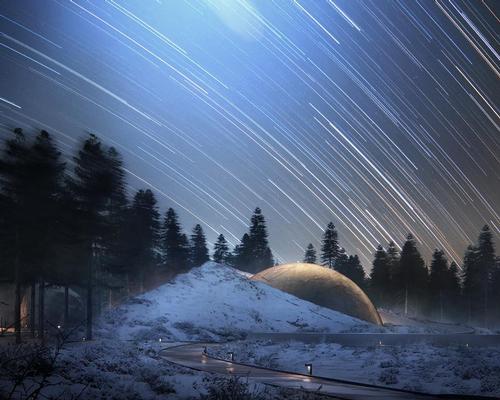02 May 2018
Snøhetta look to the stars for planetarium and visitor centre in Norway inspired by the night sky
BY Kim Megson

International architects Snøhetta have designed a new planetarium and a visitor centre for Norway’s largest astronomical facility by studying the night sky for design inspiration.
Nestled in the dense forest of Harestua, 45km north of Oslo, Solobservatoriet is the largest solar observatory North of the Alps. Its original observatory was built by the University of Oslo for the total solar eclipse of 1954, and a satellite tracking station was established by the US Air Force during the Cold War to monitor Soviet activity, before being decommissioned in the 1980s.
The Tycho Brahe Institute, named after the 16th century Danish scientist and founder of modern observational astronomy, is bankrolling the new project, turning the site into a visitor attraction. It commissioned Snøhetta to create a design that inspires a sense of wonder and curiosity, “as if the architecture itself was asking the question: ‘Where does the Universe come from?’”
The design team have embraced the interstellar theme by spreading the visitor centre’s amenities across a series of scattered cabins, each shaped like a small planet. The surfaces of these buildings will be clad with rough or smooth materials; some will appear to be halfway driven into the ground, while others will gently rest on the forest floor.
These different facilities will offer a range of scientific activities within astronomy, sun studies and natural science for “researchers, school children, retirees and international tourists.” Six of the planets alternate between 8 and 10m in diameter and can accommodate up to 10 and 32 people respectively. The smallest, ‘Zolo’, is a two-bed cabin, 6m in diameter, allowing select visitors to sleep under the stars.
The planetarium will be 1,500sq m (16,100sq ft) in size, and situated next to the observatory's original research tower. It will be orbited, like the Sun, by the ‘planet’ cabins.
The visitor experience, which will accommodate up to 118 guests, will be “an intellectual, visual and tactile journey into the realm of astronomy,” Snøhetta claimed in a statement.
Explaining their design, they added: “The planetarium is the first object that catches the eye when arriving at the facility by foot, via trails though the woodland with its grazing sheep. It’s a celestial theatre that represents over two millennia of astronomical advance and scientific progress, echoing the world’s very first planetarium which was conceived by Archimedes around 250 B.C.
“The sinuous roof is lushly planted with grass, wild heather, blueberry and lingonberry bushes, curling up from the ground. Wrapping around the golden cupola, the living roof functions as a cross between landscape and built structure that visitors can stroll on to gaze up at the starry sky. Half-sunken into the ground, the three-story theatre emerges from the earth as an orb engraved with constellations, gradually revealing itself as people approach.”
A 100-seat auditorium will feature inside the planetarium, from which visitors can watch realistically projected stars, planets and celestial objects. A reception, café and exhibition area are also planned, while a gently swirling ramp will lead up to an exhibition mezzanine and an outdoor roofscape. Below ground, there will be a large, bowl-shaped children’s activity centre.
The new-look Solobservatoriet will join a host of new planetariums, that are currently in development around the world.
Ennead Architects recently released a video glimpse of their 38,000sq m (409,000sq ft) planetarium for the Shanghai Science and Technology Museum, and images have been released for a new attraction at Edmonton’s Telus World of Science, which will boast a higher screen resolution than any other planetarium in the world.
Meanwhile, Dutch design agency NorthernLight are turning the old media centre at Sochi’s Olympic Village into a science and art park with a planetarium, Buffalo State College in New York is opening a public planetarium as part of a US$35.5m expansion; and the world’s highest planetarium is set to launch at the Tibet Museum of Natural Sciences in 2019.
Late last year, a 150-year-old gas storage facility on St Petersburg’s Obvodny Canal was fully transformed into the world’s largest planetarium, with its 37m (121ft) dome outstripping the former record holder in Nagoya, Japan.
Filling a 4,000sq m (43,000sq ft) space and capable of hosting up to 500 people at a time, Planetarium No1 features 40 8K projectors, with the dome’s screen offering a resolution of 100 million pixels.
Close Window